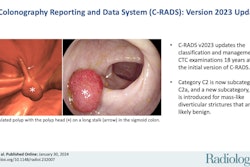
In a decision long-awaited by CT colonography (CTC) advocates, the U.S. Preventive Services Task Force (USPSTF) has finally deemed the modality to be an acceptable option for colorectal cancer screening. The determination paves the way for Medicare reimbursement and broader coverage by private payors.
CTC was included as one of seven acceptable options for colorectal cancer screening in the task force's final recommendations, which were published on Wednesday in the Journal of the American Medical Association. The new guidelines offer crucial recognition for CT colonography, a radiology-based test that has spent a generation waiting in the wings for final approval.
With the USPSTF's publication of an "A" recommendation for colorectal cancer screening in individuals ages 50 to 75 years at average risk of cancer, third-party payors are required to provide screening for asymptomatic individuals using one of the seven approved modalities, which the USPSTF listed without placing them in any order of preference (JAMA, June 15, 2016).
"This is a huge leap forward for CTC and provides us a strong platform for obtaining Medicare reimbursement," commented Dr. Judy Yee, professor and vice chair of radiology and biomedical imaging at the University of California, San Francisco, and chief of radiology at the San Francisco Veterans Affairs Medical Center.
The U.S. Centers for Medicare and Medicaid Services (CMS) is expected to embrace the USPSTF decision, which encourages doctors to meet with patients to discuss the optimal screening strategy for each individual.
The USPSTF "concludes with high certainty that screening for colorectal cancer in average-risk, asymptomatic adults aged 50 to 75 years is of substantial net benefit," the organization wrote. "Multiple screening strategies are available to choose from, with different levels of evidence to support their effectiveness, as well as unique advantages and limitations, although there are no empirical data to demonstrate that any of the reviewed strategies provide a greater net benefit. Screening for colorectal cancer is a substantially underused preventive health strategy in the United States."
Many strategies improve outcomes
The approved screening strategies include colonoscopy, the fecal immunochemical test (FIT) for occult blood, sigmoidoscopy plus FIT, and CTC. Also listed is the FIT-DNA multitargeted stool DNA test, along with a caveat that it is less efficient than the first four strategies. The USPSTF also added two final strategies, guaiac-based fecal occult blood testing (gFOBT) and sigmoidoscopy alone, but cited evidence that these are inferior to the other approved screening strategies.
The USPSTF said it "found no head-to-head studies demonstrating that any of the screening strategies it considered are more effective than others, although the tests have varying levels of evidence supporting their effectiveness, as well as different strengths and limitations."
To tie it all together, the organization recommended a shared decision-making visit with patients to discuss the appropriate screening test for each individual.
"It appears that the USPSTF has listened to the public feedback and has essentially reversed their decision to now say that each screening strategy has certain benefits and drawbacks, without any one test being 'best,' " CTC researcher Dr. Perry Pickhardt told AuntMinnie.com in an email. "This should clear the way for CMS coverage of CTC for screening of Medicare beneficiaries." Pickhard is a professor of radiology at the University of Wisconsin in Madison.
To arrive at its decision, the USPSTF reviewed the evidence and also commissioned a modeling study to provide information on the optimal starting and stopping ages for screening. In its recommendation and evidence review, the USPSTF said colorectal cancer remains a significant cause of morbidity and mortality in the U.S. It also analyzed the following:
- Seven studies of CTC with bowel preparation showed per-person sensitivity and specificity for detecting adenomas 6 mm and larger to be comparable to colonoscopy (sensitivity from 73% to 98% and specificity from 89% to 91%). Variability and imprecision in the results "may be due to differences in study designs or CTC protocols," the USPSTF wrote, adding that CTC may have harms resulting from radiation exposure or identification of extracolonic findings.
- Studies of colonoscopy found sensitivity to detect adenomas 6 mm and larger ranging from 75% to 93%. Rare complications included bowel perforations and major bleeds.
- Evaluations of the most common FITs showed good sensitivity, ranging from 73% to 88%, and specificity, ranging from 90% to 96%, the USPSTF reported.
- Four large, randomized, controlled clinical trials of flexible sigmoidoscopy found decreases in colorectal cancer-specific mortality compared with no screening (incidence rate ratio, 0.73).
- Five randomized, controlled trials with multiple rounds of biennial screening with guaiac-based FOBT showed reduced colorectal cancer-specific mortality (relative risk, 0.91 at 19.5 years; 0.78 at 30 years).
- One study of nearly 10,000 subjects found that FIT plus stool DNA had better sensitivity for detecting colorectal cancer than FIT alone (92%) but lower specificity (84%).
Patient's choice
Importantly, the USPSTF said it "recognizes that clinical decisions involve more considerations than evidence alone. Clinicians should understand the evidence but individualize decision-making to the specific patient or situation." The task force added that its policy and coverage decisions also involve considerations beyond the scientific evidence of benefits and harms.
As for older adults ages 76 to 85, the decision to screen "should be an individual one" that accounts for the patient's overall health and prior screening history. The USPSTF awarded a "C" recommendation for screening in the older age group, meaning coverage by insurers is not mandated. Older adults who have never been screened are more likely to benefit, as would adults who are healthy enough to undergo treatment if colorectal cancer is detected. Physicians are expected to engage patients approaching 75 years old to discuss when screening should end, the USPSTF said.
When screening leads to a diagnosis of adenomas or cancer, patients are followed up with a surveillance regimen and the screening recommendations no longer apply. The USPSTF did not consider the evidence on the effectiveness of any particular surveillance program after diagnosis and initial removal of polyps or cancer.
Considering the lack of evidence showing that one test is better than another, "clinicians should consider engaging patients in informed decision-making about the screening strategy that would most likely result in completion, with high adherence over time, taking into consideration both the patient's preferences and local availability," the USPSTF wrote.
If screening programs are to be successful in reducing mortality, they must be performed cohesively and in an organized way, from the first exam and interventions to the timely receipt of any follow-up or treatment.
"As the USPSTF agreed, the best test is one that patients will actually use," commented the American College of Radiology (ACR) in a statement. "A third of those who should be screened for colorectal cancer still choose not to be tested. Patients need more fully covered screening options if we are going to reduce colorectal cancer deaths."
Private insurers and Medicare should now fully cover virtual colonoscopy and the other USPSTF-recognized exams, ACR added.
CTC takes center stage
CTC "is no longer considered an alternative test by USPSTF; rather, it is classified alongside colonoscopy as a direct visualization test," Yee wrote in an email. "A consideration for CTC is that there is insufficient evidence about potential harms associated with extracolonic findings, although this is an area of controversy given the potential gains associated with being able to identify clinically significant disease potentially at an earlier stage, such as extracolonic malignancies, abdominal aortic aneurysms, osteoporosis, steatosis, etc."
The test availability of flexible sigmoidoscopy is noted to have declined in the U.S., leaving only CTC and colonoscopy as available direct visualization options in some areas. "All of these tests are now under the umbrella of the USPSTF 'A' grading for colorectal cancer screening," she said.




















